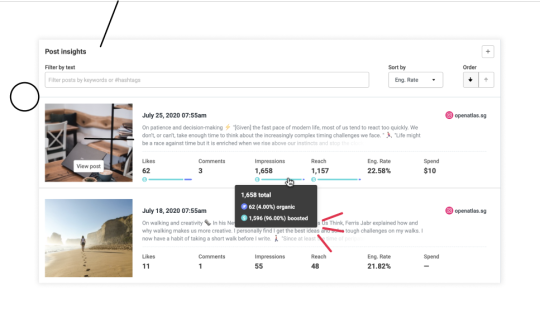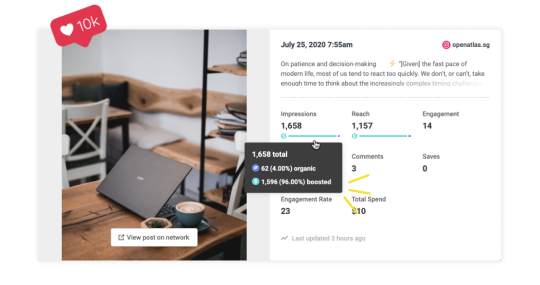
In just three simple steps, you can boost a post on Facebook and Instagram.
- Choose a post
- Select an audience
- Set your budget
That’s how easy it is.
As organic reach on social media continues to fall, businesses have started to invest more in social media advertising. For some businesses, that’s creating ads. For smaller businesses, the easier approach is often to boost Facebook posts or promote Instagram posts. Here’s why this works so well:
By putting some money behind our organic posts, we can get more results from the same amount of work.
(And if you aren’t advertising yet, boosting your Facebook and Instagram posts is a quick way to get started with advertising on those platforms—before you move into more sophisticated advertising.)
But simply throwing $5 here and $10 there isn’t enough. You need to have a strategy behind your boosted posts, and you also need a way to measure your results to ensure you get the most return on your investment.
That’s why today we’re introducing boosted post insights to Buffer.
(If you are paying for the analytics solution in Buffer, you should have this in your account already!)
How to get the best results from boosting posts
Before we get to analyzing your results, here’s a tip for choosing the best posts to boost:
Choose the posts with the highest engagement rate.
Boosting your posts is essentially paying Facebook and Instagram to show your posts to more people, according to what you have specified as the audience.
So you would want to pick the posts that will most likely generate the most engagement (or clicks depending on your goals). Posts with the highest engagement rate are proven posts. They have generated the most engagement, given the number of times people have seen it.
By boosting a post with a high engagement rate, here’s a higher chance that people who see it off the back of your ad spend will also engage with it.
Here’s a quick way to find your most engaging posts in Buffer to boost:
1. Head over to your analytics by clicking on “Analyze” at the top navigation in your Buffer account

2. Navigate to the “Posts” tab of your desired Facebook Page or Instagram account

3. Sort your posts in the “Post insights” table by “Eng. Rate”

The top few posts on the list will be great candidates for boosting. You should, however, bear in mind what you want to achieve with the boosted post and consider whether the organic post suits that purpose. For example, it will be timelier to boost a post that is meant for a marketing campaign during the campaign than after the campaign.
How to optimize your ad spend
You don’t want to just dump your money on boosted posts and forget about it. You should pay attention to the results of your boosted posts and compare the organic and paid results of your boosted posts to see how your investment has fared.
Why? By understanding the difference in your organic and paid results, you can adjust your ad spend according to the results you want to achieve. For instance, as your organic reach grows, you might want to cut back on boosting posts to a baseline so that most of your reach is from organic posts rather than boosted posts. That’s because building a brand solely through paid advertising isn’t sustainable.
With boosted post insights, there are now a few new ways to monitor your results in Buffer. Let’s run through them!
1. Overview performance
The simplest way is to see how boosting your posts has impacted your overall results. When you visit the Overview tab of a Facebook Page or Instagram account with boosted posts, you can immediately see a breakdown of organic vs paid for key metrics such as impressions and reach.
You can hover over the bar to see the exact breakdown between organic and paid.

2. Metrics growth
The next way is to track how your key metrics, such as impressions, have grown over time, especially with your boosted posts.

Are your impressions growing because of more organic impressions or paid impressions? Does that align with your strategy?
3. Post insights
The final way, and the most actionable approach, is to compare the organic and paid results of each boosted post in the “Post insights” table.

You can also click on the image to see more details of the post.

Here are a few questions you can think about while you look at these data:
- How are the paid results relative to the amount spent boosting the posts?
- Are there any boosted posts with exceptional paid results? Was it the media or the copy that might have caused more people to engage with the post? Or was it the audience setting for the boost? (You might also want to consider boosting such posts again if they are still relevant.)
- Am I getting the results I want? Should I spend more money boosting posts next month?
If you create monthly or weekly reports, you might also want to include these data. You can simply add them to a new or existing report by clicking on the “plus” button in the upper-right corner of the table or chart.
Make better decisions
There are so many different things to do as a small business. You should be able to have your data at your fingertips so that you can make swift, high-quality decisions. By comparing your organic and paid results in Buffer, you can make better decisions on investing your advertising budget and get more results.
If you value the money you spend boosting your Facebook and Instagram posts, you might enjoy our latest improvement. Try Buffer for free for 14 days and let us know what you think.
To learn more, feel free to check out our help article or join us for our upcoming webinar.
Frequently asked questions
Are ads created through Facebook Ads Manager included?
Not at the moment. After you let Buffer access your ad data, you will only see data for your boosted Facebook and Instagram posts in Buffer. If you would like to see data for your ads created through Facebook Ads Manager in Buffer, let us know!
How often are the data in Buffer updated?
The data for your Facebook Pages and Instagram accounts are updated about every six hours. We are working to improve this so that you get the most updated data whenever you visit Buffer. Also, the data you see in Buffer excludes today’s data.
I’m paying for Buffer. Why do I not see this in my Buffer account?
There are two possible reasons. First, you might not be subscribed to our analytics solution. To get boosted post insights and other analytics and reporting features, you’ll need to add this to your Buffer subscription.
Second, if you are already paying for our analytics solution, you might need to grant Buffer permission to access your ad data. You can do so under settings.
For more specific questions about the feature, see our help article.
Thank Introducing boosted post insights: Compare organic and paid results at a glance for first publishing this post.
No comments:
Post a Comment